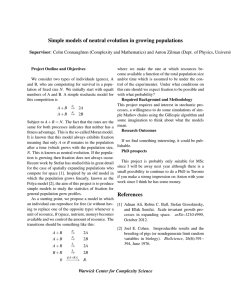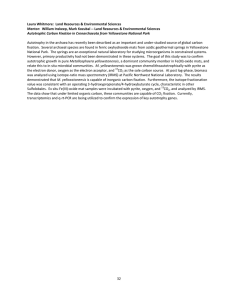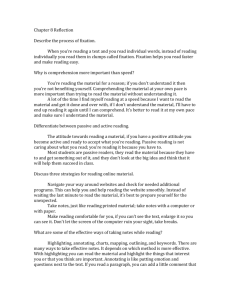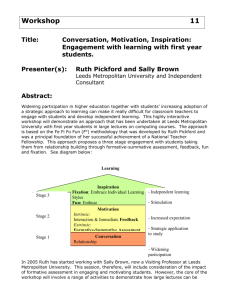Are Preferences in Emotional Processing Affected By Distraction? Examining the
advertisement
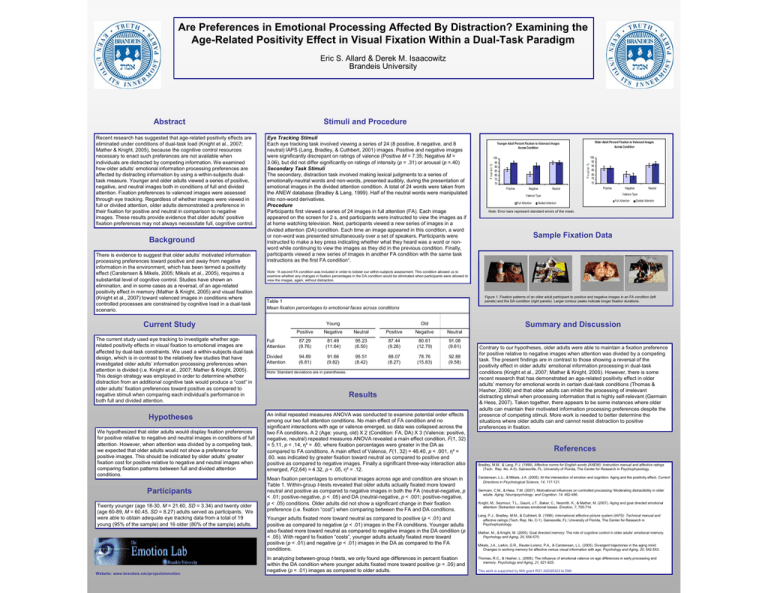
Are Preferences in Emotional Processing Affected By Distraction? Examining the Age-Related Positivity Effect in Visual Fixation Within a Dual-Task Paradigm Eric S. Allard & Derek M. Isaacowitz Brandeis University Background There is evidence to suggest that older adults’ motivated information processing preferences toward positive and away from negative information in the environment, which has been termed a positivity effect (Carstensen & Mikels, 2005; Mikels et al., 2005), requires a substantial level of cognitive control. Studies have shown an elimination, and in some cases as a reversal, of an age-related positivity effect in memory (Mather & Knight, 2005) and visual fixation (Knight et al., 2007) toward valenced images in conditions where controlled processes are constrained by cognitive load in a dual-task scenario. Eye Tracking Stimuli Each eye tracking task involved viewing a series of 24 (8 positive, 8 negative, and 8 neutral) IAPS (Lang, Bradley, & Cuthbert, 2001) images. Positive and negative images were significantly discrepant on ratings of valence (Positive M = 7.35; Negative M = 3.06), but did not differ significantly on ratings of intensity (p = .31) or arousal (p =.40) Secondary Task Stimuli The secondary, distraction task involved making lexical judgments to a series of emotionally-neutral words and non-words, presented audibly, during the presentation of emotional images in the divided attention condition. A total of 24 words were taken from the ANEW database (Bradley & Lang, 1999). Half of the neutral words were manipulated into non-word derivatives. Procedure Participants first viewed a series of 24 images in full attention (FA). Each image appeared on the screen for 2 s, and participants were instructed to view the images as if at home watching television. Next, participants viewed a new series of images in a divided attention (DA) condition. Each time an image appeared in this condition, a word or non-word was presented simultaneously over a set of speakers. Participants were instructed to make a key press indicating whether what they heard was a word or nonword while continuing to view the images as they did in the previous condition. Finally, participants viewed a new series of images in another FA condition with the same task instructions as the first FA condition¹. Hypotheses We hypothesized that older adults would display fixation preferences for positive relative to negative and neutral images in conditions of full attention. However, when attention was divided by a competing task, we expected that older adults would not show a preference for positive images. This should be indicated by older adults’ greater fixation cost for positive relative to negative and neutral images when comparing fixation patterns between full and divided attention conditions. Participants Twenty younger (age 18-30, M = 21.60, SD = 3.34) and twenty older (age 60-89, M = 60.45, SD = 8.27) adults served as participants. We were able to obtain adequate eye tracking data from a total of 19 young (95% of the sample) and 16 older (80% of the sample) adults. Website: www.brandeis.edu/projects/emotion 100 95 90 85 80 75 70 Positive Negative 100 95 90 85 80 75 70 Neutral Positive Negative Full Attention Neutral Valence Type Valence Type Divided Attention Full Attention Divided Attention Note: Error bars represent standard errors of the mean. Sample Fixation Data Note: ¹A second FA condition was included in order to bolster our within-subjects assessment. This condition allowed us to examine whether any changes in fixation percentages in the DA condition would be eliminated when participants were allowed to view the images, again, without distraction. Figure 1. Fixation patterns of an older adult participant to positive and negative images in an FA condition (left panels) and the DA condition (right panels). Larger contour peaks indicate longer fixation durations. Table 1 Mean fixation percentages to emotional faces across conditions Young Current Study The current study used eye tracking to investigate whether agerelated positivity effects in visual fixation to emotional images are affected by dual-task constraints. We used a within-subjects dual-task design, which is in contrast to the relatively few studies that have investigated older adults’ information processing preferences when attention is divided (i.e. Knight et al., 2007; Mather & Knight, 2005). This design strategy was employed in order to determine whether distraction from an additional cognitive task would produce a “cost” in older adults’ fixation preferences toward positive as compared to negative stimuli when comparing each individual’s performance in both full and divided attention. Older Adult Percent Fixation to Valenced Images Across Condition Younger Adult Percent Fixation to Valenced Images Across Condition F ix a t io n % Recent research has suggested that age-related positivity effects are eliminated under conditions of dual-task load (Knight et al., 2007; Mather & Knight, 2005), because the cognitive control resources necessary to enact such preferences are not available when individuals are distracted by competing information. We examined how older adults’ emotional information processing preferences are affected by distracting information by using a within-subjects dualtask measure. Younger and older adults viewed a series of positive, negative, and neutral images both in conditions of full and divided attention. Fixation preferences to valenced images were assessed through eye tracking. Regardless of whether images were viewed in full or divided attention, older adults demonstrated a preference in their fixation for positive and neutral in comparison to negative images. These results provide evidence that older adults’ positive fixation preferences may not always necessitate full, cognitive control. Stimuli and Procedure F ix a t io n % Abstract Old Summary and Discussion Positive Negative Neutral Positive Negative Neutral Full Attention 87.29 (9.76) 81.49 (11.64) 95.23 (6.50) 87.44 (9.26) 80.61 (12.79) 91.08 (9.61) Divided Attention 94.89 (6.81) 91.66 (9.82) 95.51 (8.42) 88.07 (8.27) 78.76 (15.83) 92.88 (9.58) Note: Standard deviations are in parentheses. Results An initial repeated measures ANOVA was conducted to examine potential order effects among our two full attention conditions. No main effect of FA condition and no significant interactions with age or valence emerged, so data was collapsed across the two FA conditions. A 2 (Age: young, old) X 2 (Condition: FA, DA) X 3 (Valence: positive, negative, neutral) repeated measures ANOVA revealed a main effect condition, F(1, 32) = 5.11, p < .14, η² = .60, where fixation percentages were greater in the DA as compared to FA conditions. A main effect of Valence, F(1, 32) = 48.40, p < .001, η² = .60, was indicated by greater fixation toward neutral as compared to positive and positive as compared to negative images. Finally a significant three-way interaction also emerged, F(2,64) = 4.32, p < .05, η² = .12. Mean fixation percentages to emotional images across age and condition are shown in Table 1. Within-group t-tests revealed that older adults actually fixated more toward neutral and positive as compared to negative images in both the FA (neutral-negative, p < .01; positive-negative, p < .05) and DA (neutral-negative, p < .001; positive-negative, p < .05) conditions. Older adults did not show a significant change in their fixation preference (i.e. fixation “cost”) when comparing between the FA and DA conditions. Younger adults fixated more toward neutral as compared to positive (p < .01) and positive as compared to negative (p < .01) images in the FA conditions. Younger adults also fixated more toward neutral as compared to negative images in the DA condition (p < .05). With regard to fixation “costs”, younger adults actually fixated more toward positive (p < .01) and negative (p < .01) images in the DA as compared to the FA conditions. In analyzing between-group t-tests, we only found age differences in percent fixation within the DA condition where younger adults fixated more toward positive (p < .05) and negative (p < .01) images as compared to older adults. Contrary to our hypotheses, older adults were able to maintain a fixation preference for positive relative to negative images when attention was divided by a competing task. The present findings are in contrast to those showing a reversal of the positivity effect in older adults’ emotional information processing in dual-task conditions (Knight et al., 2007; Mather & Knight, 2005). However, there is some recent research that has demonstrated an age-related positivity effect in older adults’ memory for emotional words in certain dual-task conditions (Thomas & Hasher, 2006) and that older adults can inhibit the processing of irrelevant distracting stimuli when processing information that is highly self-relevant (Germain & Hess, 2007). Taken together, there appears to be some instances where older adults can maintain their motivated information processing preferences despite the presence of competing stimuli. More work is needed to better determine the situations where older adults can and cannot resist distraction to positive preferences in fixation. References Bradley, M.M., & Lang, P.J. (1999). Affective norms for English words (ANEW): Instruction manual and affective ratings (Tech. Rep. No. A-5). Gainesville, FL: University of Florida, The Center for Research in Psychophysiology. Carstensen, L.L., & Mikels, J.A. (2005). At the intersection of emotion and cognition: Aging and the positivity effect. Current Directions in Psychological Science, 14, 117-121. Germain, C.M., & Hess, T.M. (2007). Motivational influences on controlled processing: Moderating distractibility in older adults. Aging, Neuropsychology, and Cognition, 14, 462-486. Knight, M., Seymour, T.L., Gaunt, J.T., Baker, C., Nesmith, K., & Mather, M. (2007). Aging and goal directed emotional attention: Distraction reverses emotional biases. Emotion, 7, 705-714. Lang, P.J., Bradley, M.M., & Cuthbert, B. (1999). International affective picture system (IAPS): Technical manual and affective ratings (Tech. Rep. No. C-1). Gainesville, FL: University of Florida, The Center for Research in Psychophysiology. Mather, M., & Knight, M. (2005). Goal directed memory: The role of cognitive control in older adults’ emotional memory. Psychology and Aging, 20, 554-570. Mikels, J.A., Larkin, G.R., Reuter-Lorenz, P.A., & Carstensen, L.L. (2005). Divergent trajectories in the aging mind: Changes in working memory for affective versus visual information with age. Psychology and Aging, 20, 542-553. Thomas, R.C., & Hasher, L. (2006). The influence of emotional valence on age differences in early processing and memory. Psychology and Aging, 21, 821-825. This work is supported by NIA grant RO1 AG026323 to DMI
